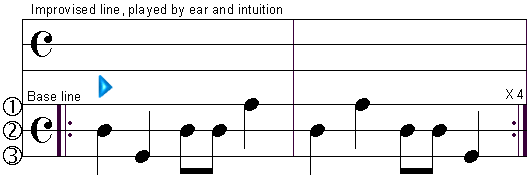MENU - INDEX - HOME
Principles of Playing
General
Teaching in a group
I. Basic Knowledge
1. Sitting position
2. Holding the Plectrum
3. Plectrum style
4. fingers-style plucking
5. Our notes' sings
6. Tuning
7. Qualities of sounds
II. Playing
General
1. Contents of playing
a) Playing one string
b) Playing two
strings
c) Playing
accompaniment
2. Creativity
a) General
b) Composing
c) Composing board
![]() d) How to improvise
d) How to improvise
e) Imp.
with drawing
f) Progressing
III. Music pieces
Go to the
Pieces...
Improvisation
General
Improvisation is defined as spontaneous, unplanned playing.
However… every improvisation is based on a ground, that is, an accepted
foundation (excluding the concept of independent improvisation). The importance of
improvisation lies in the fact that it gives students more freedom, choices and the
results are fast and in some cases amazing!
In our program the improvisation method based on
two factors:
a) The base line (the ground), a given line.
b) The improvisation line, spontaneous playing.
The base line can be given by the teacher, and it may be connected to material recently learned, which we would like to develop, For example:

